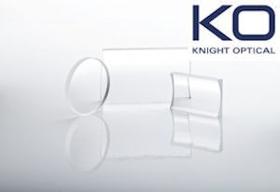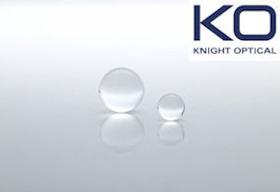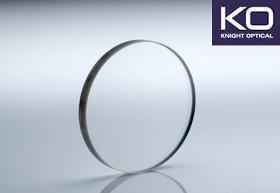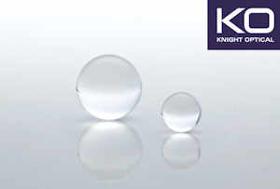- europages
- >
- COMPANIES - SUPPLIERS - SERVICE PROVIDERS
- >
- sapphires
Results for
Sapphires - Import export

KNIGHT OPTICAL (UK) LTD
United Kingdom
Sapphire (Al2O3) is one of the hardest minerals and optical materials available for use in the range from UV up to 5µm. Sapphire is birefringent and if its use is for critical optical application then the crystal might have to be cut along the zero degree plane, or C-Cut. Random cut is usually cut along a plane that is 60° off-axis as the growth in this direction is the easiest to grow. Random cut is anything that is not the C-Cut angle. Sapphire can fluoresce depending upon the concentration of other minerals within the lattice, for example Iron (Fe) or Chromium (Cr). Clear Sapphire might fluoresce orange when illuminated by UV light if impurities are in the crystal. Fluorescent free Sapphire has to be grown from 'pure' feedstock and seed and in an environment that cannot place impurities into the lattice. READ MORE ... CLICK LINK
Request for a quote
KNIGHT OPTICAL (UK) LTD
United Kingdom
Sapphire is an incredibly hard crystal (HK1370kg/mm2), second only to diamond. Fluoresence free sapphire windows have high mechanical strength, thermal and chemical resistance and is scratch resistant, making it very desirable for operating in harsh conditions. Sapphire windows can be made thinner than alternative crystals thanks to its structural integrity and can operate up to 2030⁰C. The material transmits between the UV and IR at 0.15-5.5µm, and has a high refractive index of 1.75.. Knight Optical supply a range of quality Sapphire optical components including Fluoresence free sapphire windows, Sapphire lenses, Sapphire prisms, and Sapphire blanks either from stock or bespoke custom made to your specification for a range of applications. Our current range includes Random Polarization Sapphire that can be used for most applications apart from UV use. Click link URL to read more …
Request for a quote
KNIGHT OPTICAL (UK) LTD
United Kingdom
Sapphire is an incredibly hard crystal (HK1370kg/mm2), second only to diamond. Fluoresence free sapphire windows have high mechanical strength, thermal and chemical resistance and is scratch resistant, making it very desirable for operating in harsh conditions. Sapphire windows can be made thinner than alternative crystals thanks to its structural integrity and can operate up to 2030⁰C. The material transmits between the UV and IR at 0.15-5.5µm, and has a high refractive index of 1.75.. Knight Optical supply a range of quality Sapphire optical components including Fluoresence free sapphire windows, Sapphire lenses, Sapphire prisms, and Sapphire blanks either from stock or bespoke custom made to your specification for a range of applications. Our current range includes Random Polarization Sapphire that can be used for most applications apart from UV use. Click link URL to read more …
Request for a quote
KNIGHT OPTICAL (UK) LTD
United Kingdom
When it comes to a high quality IR Cut filter, it is the substrate with the coating applied that affects the performance. Knight Optical provide high quality wafers for precisely this, and the surface quality of our substrates eliminates blotching at the sensor which occurs on lower quality substrates especially where IR Cut filters are concerned. Our wafers are produced as thin as 500μm & provide exceptional surface quality. However, we can manufacture to a fully customised specification with a wafer thickness as little as 10 μm. Our substrates for stock or custom can be manufactured from a great deal of materials including: •Quartz •Borosilicate •BK7 or equivalent •Sapphire •And many more. Depending on your application for the IR Cut Filter, we can help advise on the best achievable optic for your application. Please read PDF for full specification
Request for a quote
KNIGHT OPTICAL (UK) LTD
United Kingdom
Knight Optical can offer you Custom Sapphire Cylindrical Lenses, for use within Endoscopes. We supply a range of Sapphire options for a variety of applications – all individually QA checked and metrology tested for quality to ensure parts meet customers’ specifications. What’re more, our Sapphire Cylindrical Lenses are supplied in a range of sizes and shapes with custom coatings tailored to meet your individual applications. Sapphire (Al2O3) is one of the hardest minerals and optical materials available for use in the range from UV up to 5µm, making it ideal as a protective window for camera systems. Cylindrical lenses are designed to focus light into a straight line, rather than to a single point. As the name suggests, the lens surface has a cylindrical shape rather than the usual spherical formation, which allows for one-dimensional shaping of light along a line. Cylindrical lenses are often used to change the profile of laser beams; for example Read PDF for more info
Request for a quoteDo you sell or make similar products?
Sign up to europages and have your products listed

KNIGHT OPTICAL (UK) LTD
United Kingdom
Knight Optical offer a range of Stock Ball Lenses and Half Ball Lenses, for use within Fibre Optics, Signal Coupling and Barcode Scanners. As the name suggests ball lenses are spherical lenses mostly made out of High Refractive Index Glass such as Sapphire, and LASFN-9 Glass. The reason ball lenses are most commonly used is for their ability to couple light in and out of fibres. The key feature of ball lenses is their short back focal length allowing for precision coupling where size or space is a limiting factor in the system. Ball lenses are typically used in pairs with one lens acting as a collimator for the second to focus the light back into the coupled fibre. Where a more compact solution is required a half-ball lens is typically more suitable. We hold a large inventory of Ball Lenses. •Stock sizes from 0.5 5mm to 10mm diameter. •Custom sizes available to quotation. •Half Ball lenses also available. For more information read PDF….
Request for a quote
KNIGHT OPTICAL (UK) LTD
United Kingdom
Knight Optical offer a range of Stock Sapphire Windows, and custom for use within Airborne LiDAR Systems. These are systems used in surveying for topographical measurements. The data accumulated can be used to generate a Digital Terrain Model or a Digital Elevation Model which are 3D representations of terrain. Sapphire (Al2O3) is one of the hardest minerals and optical materials available for use in the range from UV up to 5µm. Making it ideal as a protective window for airborne systems which may be utilised in harsh environment or against birds! Sapphire is grown by various methods from seed samples. Sapphire can be polished to a high standard, but as it is the second hardest mineral on Earth it must be subject to high forces to polish. Therefore, windows made from Sapphire must have a thickness to diameter ratio of at least 10:1, that is, greater For more information read PDF….
Request for a quote
KNIGHT OPTICAL (UK) LTD
United Kingdom
Sapphire (Al2O3) is one of the hardest minerals and optical materials available for use in the range from UV up to 5µm. Sapphire is birefringent and if its use is for critical optical application then the crystal might have to be cut along the zero degree plane, or C-Cut. Random cut is usually cut along a plane that is 60° off-axis as the growth in this direction is the easiest to grow. Random cut is anything that is not the C-Cut angle. Sapphire can fluoresce depending upon the concentration of other minerals within the lattice, for example Iron (Fe) or Chromium (Cr). Clear Sapphire might fluoresce orange when illuminated by UV light if impurities are in the crystal. Fluorescent free Sapphire has to be grown from 'pure' feedstock and seed and in an environment that cannot place impurities into the lattice. Click PDF link to read more …...
Request for a quote
KNIGHT OPTICAL (UK) LTD
United Kingdom
The laser mirrors can be custom made to include the following range: 1 YAG laser mirrors (High power grade) 2 Excimer laser mirrors (High power grade) 3 Argon-ion laser mirrors (High power grade) 4 Diode & broadband (Ti:Sapphire) These mirrors are made from vacuum depositing thin films of material that have differing refractive indices & thickness onto suitable substrates. Typical custom laser mirror substrates are calcium fluoride, germanium, sapphire, fused silica and Zinc Selenide which produce a high efficiency reflecting surface at the laser wavelength. The coatings are assembled assuming that the mirror will be working in the plane of incidence. This is essential as any off-axis angles will push the pass band toward the shorter waveband that could be beyond the pass band for one or both polarizations (s and p). If off-axis reflections are needed, such as at 90°, then this coating needs to be applied for an Angle of Incidence (AOI) of 45°. READ PDF FOR MORE INFO ..
Request for a quote
KNIGHT OPTICAL (UK) LTD
United Kingdom
Our uncoated Precision Ball Lenses can be achieve a very high level of yield of magnification & are widely used for focusing & coupling light into and out of Microscopes. We can offer these in Sapphire, made from Al2O3, and BK7 or equivalent material. Sapphire allows for superior optical transmission qualities The key feature of ball lenses is their short back focal length allowing for precision coupling where size or space is a limiting factor in the system & therefore ideal in the use of Microscopes or microscopic attachments onto devices such as mobile phones. Ball Lenses are manufactured from a single substrate of glad and therefore, depending on the geometry of the input source, can focus or collimate light. Half Ball Lenses can also be used as an interchange with a full ball lens for more compact designs. Read the PDF for more information....
Request for a quote
KNIGHT OPTICAL (UK) LTD
United Kingdom
Knight Optical offer a range of Stock Ball Lenses and Half Ball Lenses, for use within Fibre Lasers. As the name suggests ball lenses are completely spherical lenses mostly made out of High Refractive Index Glass such as Sapphire, and LASFN-9 Glass. The reason ball lenses are most commonly used is for their ability to focus light when leaving a fibre optic, so that it can therefore be used for a laser application. The key feature of ball lenses is their short back focal length allowing for precision coupling where size or space is a limiting factor in the system. Ball lenses are typically used in pairs with one lens acting as a collimator for the second to focus the light back into the coupled fibre. Where a more compact solution is required a half-ball lens is typically more suitable. We hold a large inventory of Ball Lenses. •Stock sizes from 0.5 5mm to 10mm diameter. •Custom sizes available to quotation. •Half Ball lenses also available.
Request for a quoteResults for
Sapphires - Import exportNumber of results
12 ProductsCountries
Company type